Efficiently Check Status with Guardrails
Overview
In this tutorial, we will walk through the steps to set up guardrails for a Check Status Vessel to ensure that downstream processes don't run until an upstream job finishes.
By the end of the tutorial, you'll be able to:
- Set up a Vessel using a Check Status Blueprint.
- Set up guardrails to make the Vessel run efficiently.
Background
Platform's Check Status Blueprints are designed to quickly ping the desired vendor, asking "What's the status of job X?". If job X is incomplete, the Vessel will fail - by design. Vessels built with these Blueprints were designed to be used together with guardrails, which automatically retry a Vessel after seeing a failure.
With guardrails in place, Platform will retry after a specified period of time and once again ask the vendor "What's the status of job X?". Once the vendor returns with any answer other than incomplete
- If the answer is success, the Vessel will finish successfully.
- If the answer is errored, canceled, or any other negative response, a unique exit code will be generated and the Vessel will error. If this exit code is found in the list of exclusions the Vessel will no longer be retried.
With this strategy, Vessels built with the Check Status Blueprint will check the status the minimum number of times until a final answer is received. Since the time between retries is not part of billable runtime this is both a cost-effective and time-efficient strategy.
Without this strategy there are two outcomes:
- The Check Status Blueprint ends prematurely with an error, before the job has completed on the vendor's service.
- Your Fleet runs without regard to a previously kicked off job's status.
Setup
This tutorial will use the Check Sync Status Blueprint from Fivetran. The steps in this tutorial will work with any Integration that has a Check Status Blueprint such as dbt Cloud or Tableau.
- Create a new Fleet.
- Add a Vessel to the new Fleet that uses the Fivetran - Execute Sync Blueprint.
- Name the Vessel: Execute Fivetran Sync.
- Enter your API Key, API Secret, and Connector ID under Inputs.

Now that we have a Vessel that will execute a sync in Fivetran, we can setup a Vessel that will check the status of that sync.
Steps
- Create a new Vessel using the Fivetran - Check Sync Status Blueprint.
- Name the Vessel: Check Fivetran Sync Status
- Enter your API Key and API Secret under Inputs.
When connecting a check status Blueprint to an execute task Blueprint, you do not have to enter in the id of your run. We will grab that value from the upstream Vessel.
- Expand the Guardrails menu
- Under
Number of Retries, select 24x. - Under
Time Between Retries, select 5m.
If there are values under the Exclude Exit Code Ranges option, leave these alone! These tell Platform to not retry if a final status of an error is found.

The guardrail setup above will wait for up to 2 hours (5m*24 retries) for something to complete. For longer runs, you may need to increase the Time Between Retries. For shorter runs, you can adjust the Time Between Retries to be ASAP (~30s).
- Connect the Execute Fivetran Sync Vessel to the Check Fivetran Sync Status Vessel.

You've successfully set up guardrails to make your check status Vessels run more efficiently.